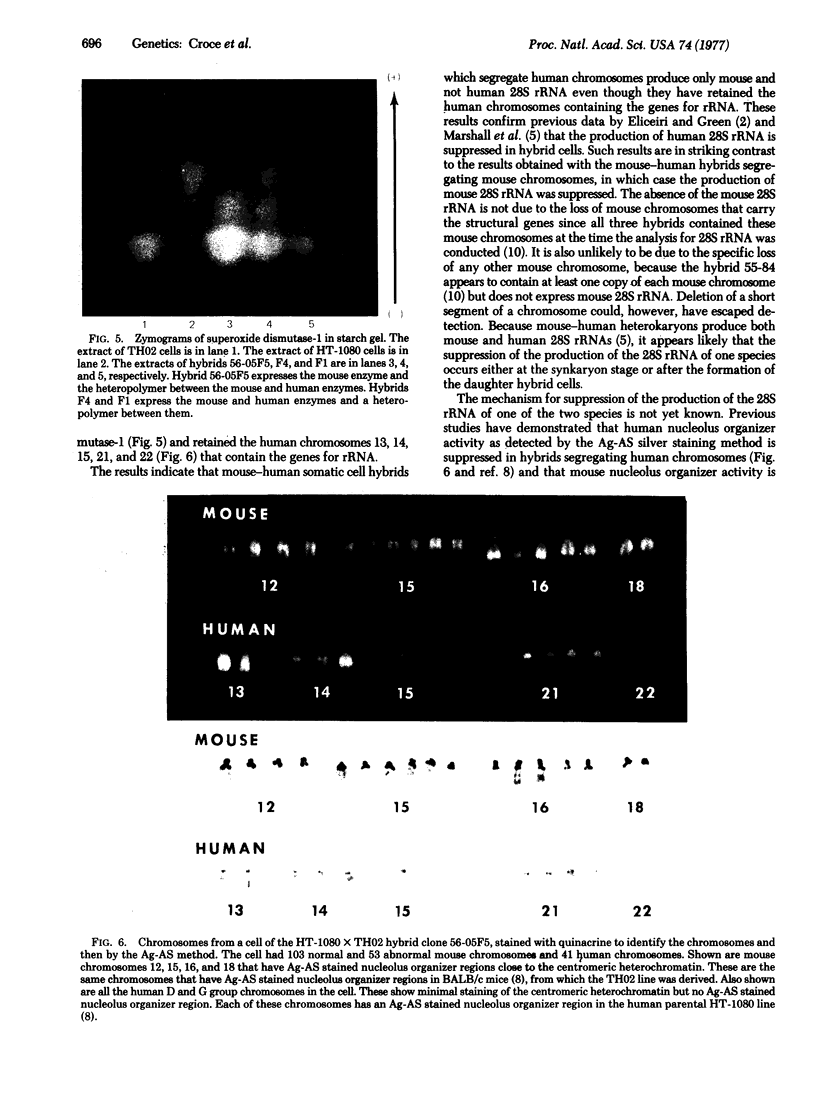Abstract
Mouse-human somatic cell hybrids that lose (segregate) human chromosomes produce only mouse 28S ribosomal RNA even when they retain copies of the human chromosomes that contain the genes for 28S ribosomal RNA. In contrast, mouse-human hybrid cells that segregate mouse chromosomes produce only human 28S ribosomal RNA even when they have retained copies of mouse chromosomes that contain the 28S ribosomal RNA genes.
Full text
PDF



Images in this article
Selected References
These references are in PubMed. This may not be the complete list of references from this article.
- Cassidy D. M., Blackler A. W. Repression of nucleolar organizer activity in an interspecific hybrid of the genus Xenopus. Dev Biol. 1974 Nov;41(1):84–96. doi: 10.1016/0012-1606(74)90285-1. [DOI] [PubMed] [Google Scholar]
- Chern C. J., Croce C. M. Assignment of the structural gene for human beta glucuronidase to chromosome 7 and tetrameric association of subunits in the enzyme molecule. Am J Hum Genet. 1976 Jul;28(4):350–356. [PMC free article] [PubMed] [Google Scholar]
- Croce C. M., Koprowski H., Eagle H. Effect of environmental pH on the efficiency of cellular hybridization. Proc Natl Acad Sci U S A. 1972 Jul;69(7):1953–1956. doi: 10.1073/pnas.69.7.1953. [DOI] [PMC free article] [PubMed] [Google Scholar]
- Croce C. M. Loss of mouse chromosomes in somatic cell hybrids between HT-1080 human fibrosarcoma cells and mouse peritioneal macrophages. Proc Natl Acad Sci U S A. 1976 Sep;73(9):3248–3252. doi: 10.1073/pnas.73.9.3248. [DOI] [PMC free article] [PubMed] [Google Scholar]
- Eliceiri G. L., Green H. Ribosomal RNA synthesis in human-mouse hybrid cells. J Mol Biol. 1969 Apr;41(2):253–260. doi: 10.1016/0022-2836(69)90390-8. [DOI] [PubMed] [Google Scholar]
- Henderson A. S., Warburton D., Atwood K. C. Location of ribosomal DNA in the human chromosome complement. Proc Natl Acad Sci U S A. 1972 Nov;69(11):3394–3398. doi: 10.1073/pnas.69.11.3394. [DOI] [PMC free article] [PubMed] [Google Scholar]
- Honjo T., Reeder R. H. Preferential transcription of Xenopus laevis ribosomal RNA in interspecies hybrids between Xenopus laevis and Xenopus mulleri. J Mol Biol. 1973 Oct 25;80(2):217–228. doi: 10.1016/0022-2836(73)90168-x. [DOI] [PubMed] [Google Scholar]
- Hsu T. C., Spirito S. E., Pardue M. L. Distribution of 18+28S ribosomal genes in mammalian genomes. Chromosoma. 1975 Nov 20;53(1):25–36. doi: 10.1007/BF00329388. [DOI] [PubMed] [Google Scholar]
- Jha K. K., Ozer H. L. Expression of transformation in cell hybrids. I. Isolation and application of density-inhibited Balb/3T3 cells deficient in hypoxanthine phosphoribosyltransferase and resistant to ouabain. Somatic Cell Genet. 1976 May;2(3):215–223. doi: 10.1007/BF01538960. [DOI] [PubMed] [Google Scholar]
- LITTLEFIELD J. W. SELECTION OF HYBRIDS FROM MATINGS OF FIBROBLASTS IN VITRO AND THEIR PRESUMED RECOMBINANTS. Science. 1964 Aug 14;145(3633):709–710. doi: 10.1126/science.145.3633.709. [DOI] [PubMed] [Google Scholar]
- Marshall C. J. Synthesis of ribosomal RNA in synkaryons and heterokaryons formed between human and rodent cells. J Cell Sci. 1975 Mar;17(3):307–325. doi: 10.1242/jcs.17.3.307. [DOI] [PubMed] [Google Scholar]
- Miller D. A., Dev V. G., Tantravahi R., Miller O. J. Suppression of human nucleolus organizer activity in mouse-human somatic hybrid cells. Exp Cell Res. 1976 Sep;101(2):235–243. doi: 10.1016/0014-4827(76)90373-6. [DOI] [PubMed] [Google Scholar]
- Miller O. J., Miller D. A., Dev V. G., Tantravahi R., Croce C. M. Expression of human and suppression of mouse nucleolus organizer activity in mouse-human somatic cell hybrids. Proc Natl Acad Sci U S A. 1976 Dec;73(12):4531–4535. doi: 10.1073/pnas.73.12.4531. [DOI] [PMC free article] [PubMed] [Google Scholar]
- Miller O. J., Miller D. A., Kouri R. E., Allderdice P. W., Dev V. G., Grewal M. S., Hutton J. J. Identification of the mouse karyotype by quinacrine fluorescence, and tentative assignment of seven linkage groups. Proc Natl Acad Sci U S A. 1971 Jul;68(7):1530–1533. doi: 10.1073/pnas.68.7.1530. [DOI] [PMC free article] [PubMed] [Google Scholar]
- Ricciuti F., Ruddle F. H. Assignment of nucleoside phosphorylase to D-14 and localization of X-linked loci in man by somatic cell genetics. Nat New Biol. 1973 Feb 7;241(110):180–182. doi: 10.1038/newbio241180a0. [DOI] [PubMed] [Google Scholar]
- Ruddle F. H., Creagan R. P. Parasexual approaches to the genetics of man. Annu Rev Genet. 1975;9:407–486. doi: 10.1146/annurev.ge.09.120175.002203. [DOI] [PubMed] [Google Scholar]
- Seabright M. A rapid banding technique for human chromosomes. Lancet. 1971 Oct 30;2(7731):971–972. doi: 10.1016/s0140-6736(71)90287-x. [DOI] [PubMed] [Google Scholar]
- Siminovitch L. On the nature of hereditable variation in cultured somatic cells. Cell. 1976 Jan;7(1):1–11. doi: 10.1016/0092-8674(76)90249-x. [DOI] [PubMed] [Google Scholar]
- Toniolo D., Meiss H. K., Basilico C. A temperature-sensitive mutation affecting 28S ribosomal RNA production in mammalian cells. Proc Natl Acad Sci U S A. 1973 Apr;70(4):1273–1277. doi: 10.1073/pnas.70.4.1273. [DOI] [PMC free article] [PubMed] [Google Scholar]
- Weiss M. C., Green H. Human-mouse hybrid cell lines containing partial complements of human chromosomes and functioning human genes. Proc Natl Acad Sci U S A. 1967 Sep;58(3):1104–1111. doi: 10.1073/pnas.58.3.1104. [DOI] [PMC free article] [PubMed] [Google Scholar]
- van Heyningen V., Bobrow M., Bodmer W. F., Gardiner S. E., Povey S., Hopkinson D. A. Chromosome assignment of some human enzyme loci: mitochondrial malate dehydrogenase to 7, mannosephosphate isomerase and pyruvate kinase to 15 and probably, esterase D to 13. Ann Hum Genet. 1975 Jan;38(3):295–303. doi: 10.1111/j.1469-1809.1975.tb00613.x. [DOI] [PubMed] [Google Scholar]






